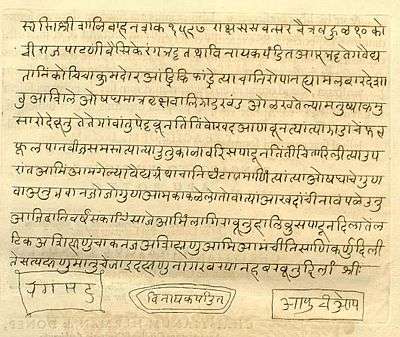Nagar Barap
| Nāgarī Barap [1] | |
|---|---|
 Hortus Malabaricus by Ranga Bhat, Vinayaka Pandit, and Appu Bhat. | |
| Type | |
Time period | c. 2nd century CE – present [2] |
Parent systems | |
Child systems | Devanagari, Eastern Nāgarī, Nandi Nāgarī |
| Direction | Left-to-right |
| ISO 15924 |
Deva, 315 |
Unicode alias | Devanagari |
| U+0900–U+097F and U+A8E0–U+A8FF | |
| Brahmic scripts |
|---|
| The Brahmic script and its descendants |
|
Northern Brahmic
|
Nāgar Barap (/ˈnɑːɡərbərəp/; नागर बरप Nāgar Barap — Nāgar नागर 'urban' and barap बरप writing) is an abugida alphabet of India. It was the predecessor of the Devanagari script It is written from left to right, does not have distinct letter cases, and is recognizable (along with most other North Indic scripts, with the Gujarati script being an exception) by a horizontal line that runs along the top of full letters.
Origins
Nāgar Barap is part of the Brahmic family of scripts of India, Nepal, Tibet, and South-East Asia.[4] It is a descendant of the Gupta script, along with Siddham and Sharada.[4] Eastern variants of Gupta called Nāgarī are first attested from the 8th century; from c. 1200 these gradually replaced Siddham, which survived as a vehicle for Tantric Buddhism in East Asia, and Sharada, which remained in parallel use in Kashmir. An early version of Devanagari is visible in the Kutila inscription of Bareilly dated to Vikram Samvat 1049 (i.e. 992 CE), which demonstrates the emergence of the horizontal bar to group letters belonging to a word.[5]
References
- ↑ refer Hortus Malabaricus Certificate where the Devanagari-based script for Konkani is called Nāgarī Barap
- ↑ The earliest inscription in Konkani found in the village of Aravalem, in Goa (शचिपुराचे शिरसि)
- ↑ refer Hortus Malabaricus Certificate where the Devanagari-based script for Konkani is called Nāgarī Barap
- 1 2 Steven Roger Fischer (2004), A history of writing, Reaktion Books, ISBN 978-1-86189-167-9,
... an early branch of this, as of the fourth century AD, was the Gupta script, Brahmi's first main daughter ... the Gupta alphabet became the ancestor of most Indic scripts (usually through later Devanagari) ... Nagari, of India's north-west, first appeared around AD 633 ... in the eleventh century, Nagari had become Devanagari, or 'heavenly Nagari', since it was now the main vehicle, out of several, for Sanskrit literature ...
- ↑ Isaac Taylor (2003), History of the Alphabet: Aryan Alphabets, Part 2, Kessinger Publishing, ISBN 978-0-7661-5847-4,
... In the Kutila this develops into a short horizontal bar, which, in the Devanagari, becomes a continuous horizontal line ... three cardinal inscriptions of this epoch, namely, the Kutila or Bareli inscription of 992, the Chalukya or Kistna inscription of 945, and a Kawi inscription of 919 ... the Kutila inscription is of great importance in Indian epigraphy, not only from its precise date, but from its offering a definite early form of the standard Indian alphabet, the Devanagari ...